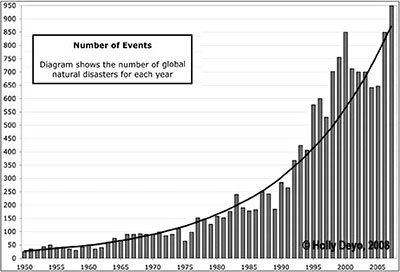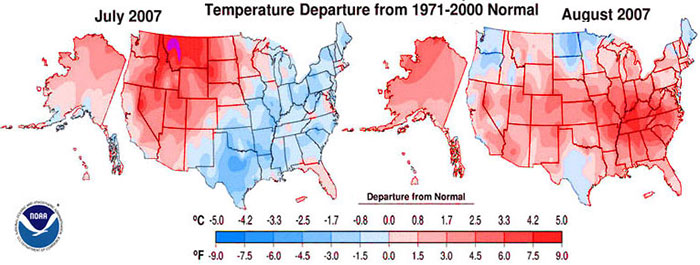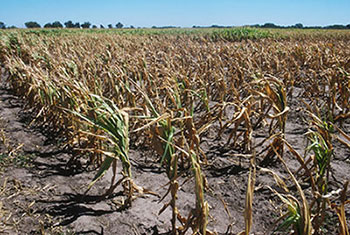DISASTERS ROCKET UP
Holly Deyo
 While
were busy with life last year, upheaval raged. An astounding 950 natural
disasters struck around the world according to Munich Re, the global
reinsurance company. Though no mega-catastrophes developed as large as
Hurricane Katrina, the number of devastating events shot through the roof.
'Unlucky' 2007 demolished 2006's numbers - the next highest disaster-rated
year. It racked up another 100 events jumping 10%.
While
were busy with life last year, upheaval raged. An astounding 950 natural
disasters struck around the world according to Munich Re, the global
reinsurance company. Though no mega-catastrophes developed as large as
Hurricane Katrina, the number of devastating events shot through the roof.
'Unlucky' 2007 demolished 2006's numbers - the next highest disaster-rated
year. It racked up another 100 events jumping 10%.WICKED COLD
January '07 brought a crippling widespread freeze to California dropping temps overnight into the 20s. In just two weeks, frigid weather killed off $1.5 billion of citrus, berries, and vegetables.
 Then
a freak Spring freeze extending from the Midwest through the South, took
another $2 billion of our fruit and wheat crops. Because these Arctic
temps were accompanied by high winds, it rendered all the normal
crop-protection methods useless.
Then
a freak Spring freeze extending from the Midwest through the South, took
another $2 billion of our fruit and wheat crops. Because these Arctic
temps were accompanied by high winds, it rendered all the normal
crop-protection methods useless.MEGA-DROUGHT
For the entire year of 2007, record drought severely impacted water supplies and reduced major food supplies around the world. Drought continuously hammered Australia killing crops and livestock. The most shattering effect was seen when Aussie farmers, unable to cope, committed suicide.
GLOBAL HEAT
It might seem strange to talk about heat waves during 2008's unprecedented snows and bitterly cold temps, but rocketing temps struck worldwide just months ago. Not only did Greece, Italy, Albania, Bulgaria, Romania and Turkey experience record-breaking temperatures, most of Asia sweltered in blistering weather too. Ditto for the Americas.

June and July brought a wide swath of freakish heat from Mexico to
Alberta, and from Saskatchewan into Ontario. It swooped southward and
engulfed the entire western US. By August, temperatures soared throughout
the Midwest and into much of the south causing at least $5 billion in
damages.
 More
U.S. crops succumbed to nature's onslaught when some areas experienced the
worst drought in 100 years. Precious wheat, corn and other grain crops
withered under the merciless sun. Records shattered worldwide with temps
jumping as much as 23ºF above the norm.
More
U.S. crops succumbed to nature's onslaught when some areas experienced the
worst drought in 100 years. Precious wheat, corn and other grain crops
withered under the merciless sun. Records shattered worldwide with temps
jumping as much as 23ºF above the norm.
Photo: Drought-damaged corn, central Nebraska (University of Nebraska
Board of Regents)
SCORCHED EARTH
Wildfire season got off to a lazy start last year fooling people into
thinking we'd get off easy. In March, fires fried parts of the Tennessee
Valley and the Southeast. By April and May, they had spread to northern
Minnesota and down through southern Florida. July arrived and all thoughts
of it being a quiet fire year went down in a heap of ash.
July exploded with the force of TNT as wildfires ignited across the West,
pushing further north and south. By late Fall, the worst hit southern
California. Brutal Santa
 Ana
winds whipped without pause. Before 2007 closed, over 3,000 homes burned
down and well over 9 million acres were charred.
Ana
winds whipped without pause. Before 2007 closed, over 3,000 homes burned
down and well over 9 million acres were charred.
Since 1960, only 2006 saw more fires. Just two days ago, in Winter's
harshest grasp, 63 wildfires burned in Texas, Louisiana, Florida, Georgia,
South Carolina, North Carolina, Kentucky and Canada with a red flag
warning for Texas.
Image: More than 85,000 separate fires ravaged the U.S. during 2007 -
nipping at the 2006 record.
But that is behind us now so we forget until the next disaster fires our
memory.
HUFF AND PUFF
Normally we see about 1000 tornadoes a year. During 2007, 1,300 twisters
ripped through the U.S. This barrage of unrelenting windstorms plagued the
Midwest and rampaged eastward. Then something new happened: an unheard of
twister barreled across Brooklyn, NY.
This year, in a single February night, 68 tornadoes roared through
Alabama, Arkansas,
 Kentucky,
Mississippi and Tennessee. At least 58 people died: 32 in Tennessee, 13 in
Arkansas, 7 in Kentucky and 6 in Alabama. This tornado outbreak was the
nation's worst in more than two decades when 76 people were killed in
Pennsylvania and Ohio on May 31, 1985. May, not February.
The death toll ranks among the top 15 from tornado outbreaks since 1950.
Again, this is tornado off-season.
Kentucky,
Mississippi and Tennessee. At least 58 people died: 32 in Tennessee, 13 in
Arkansas, 7 in Kentucky and 6 in Alabama. This tornado outbreak was the
nation's worst in more than two decades when 76 people were killed in
Pennsylvania and Ohio on May 31, 1985. May, not February.
The death toll ranks among the top 15 from tornado outbreaks since 1950.
Again, this is tornado off-season.
Photo: Michael Keisling, 5, and his dog, Mattie, sit among the rubble that
was their house and watch others begin the cleanup in Hartsville, Tenn.,
Wednesday, Feb. 6, 2008, after tornadoes went through the area the night
before. Michael, his mother, Lea, and Mattie were all in the home when the
storm hit and all survived. (Mark Humphrey / AP)
This very out-of-character wild weather has prompted scientists to ask if
January is the new March.
January 2008 - when it's supposed to be snowing - an unbelievable
136 tornadoes wrecked terrible damage. January usually sees about 34
twisters.
The 103 tornadoes that struck Tuesday-Wednesday is 412% more than the
ENTIRE month of February should see. February is typically the quietest
month for tornado activity. You've got to admit something very
different and very dangerous is going on here. At this vastly accelerated
rate, well, who knows how rough this year will be...
Nearly 300 tornadoes in the first 6 weeks show 2008 is not off to a
good start.
WEATHERING EXTREMES
If there is a pattern here, it is one of unbelievable extremes. If it
snows; it dumps. If it's cold; it's bitter. If it rains, it's a deluge. If
it blows, it's tornadic. When things dry out, it turns into mega-drought.
Disasters ricochet from flood to drought and from freeze to fry. Hail,
tornadoes, floods and severe thunderstorms are all hitting our harvests
and there is no reason to think they will quiet.
Last month brought really weird events.
- Rare winter tornadoes in the Midwest.
- Powerful Pacific storms with hurricane force winds.
- More than 1,000 daily high temperature records.
And that's just in the first month of 2008.
Originally published at: http://standeyo.com/News_Files/Food/DFSP.html